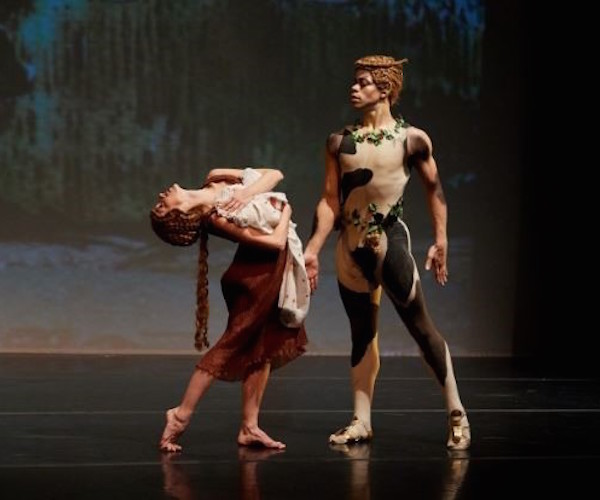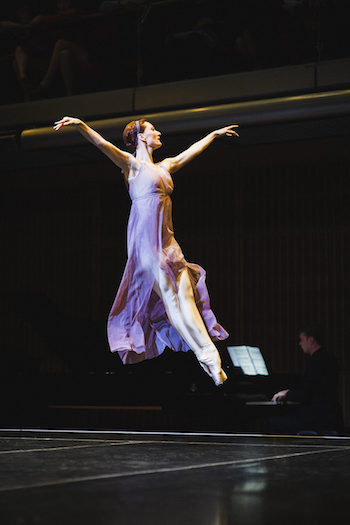Dance Review: Displaced Persons — New York Theatre Ballet at Gardner Museum
Going beyond the reasonable concept, there was the New York Theatre Ballet’s performance.

New York Theatre Ballet performing Vaslav Nijinsky’s Afternoon of a Faun.” Photo: Rachel Neville.
By Marcia B. Siegel
New York Theatre Ballet is a chamber-sized company with an eclectic ballet-centered repertory, based at St. Marks Church in the Bowery. They often perform in the sanctuary, a cleared-out room now called Danspace, where the offbeat dance population in NYC frequently holds forth. But NYTB also gives performances in small theaters. The odd thing is why they were presented here at the Isabella Stewart Gardner Museum’s Calderwood Hall. The Hall is a high open space in the new wing of the Gardner, with seats on all four sides and on four levels. Musical concerts are given there, and reportedly the acoustics are great.
But the sightlines for dance aren’t great, and all three works in NYTB’s program Thursday night were oriented to a proscenium front. Perhaps the presenters were guided by Merce Cunningham’s notion that a dance can be seen from any angle, and that no matter where you sit, the dance you see is the dance. This is a reasonable concept, as applied to a genre-spanning art institution founded in the Renaissance-replica home of a collector of Old Masters, with a classy new addition built in the 21st century.
I can see why these dances were chosen, to reflect the Gardner’s upcoming exhibition Life, Death & Revelry, featuring the Farnese Sarcophagus. The one-night NYTB show was given the title The Classical World in Modern Choreography. All the pieces were imaginings of ancient Greek characters.
So far so good, but going beyond the concept, there was the performance. First, “Afternoon of a Faun,” premiered by the Diaghilev Ballets Russes in 1912. The “Faun” was the first of only four choreographies by Vaslav Nijinsky, a work almost as celebrated – and scandalous – as the dancer himself. Nijinsky envisioned the little encounter between a faun and some nymphs like figures on a flat canvas or a frieze, traveling in planes across the stage. The movement was to look two-dimensional, with the dancers’ torsos turned sideways as their feet advanced forward. The hands were flat, gesturing with thumbs up. Behind them was a backdrop painted in lush greens and gold, by the Ballets Russes’s noted designer Léon Bakst. Though the ballet created an uproar because of the Faun’s suggestive embracing of the veil dropped by the retreating nymph, it became a repertory favorite after the end of the Ballets Russes in 1929, adapting slightly to successive performers.
NYTB danced it in 2017, in the version retrieved by Ann Hutchinson Guest and Claudia Jeschke from a score written by Nijinsky around 1919, when he was in exile and soon to be diagonsed as schizophrenic. Guest and Jeschke translated Nijinsky’s personal notation into the more widely used Labanotation, and when they staged the “Faun” for young dancers, the movement looked much less jagged and jerky than most other revivals.
At the Gardner, without the backdrop and with a simple set of stairs and platform substituting for the Faun’s forest hideaway, the ballet looked untheatrical. Adam Marks and Michael Scales played Debussy’s lush orchestral score in a two-piano reduction, as they did for all three works on the program. Steven Melendez’s Faun, Elena Zahlmann’s Leading Nymph, and the other six nymphs elided the transitions between moves, rounded off the corners, and made the interactions a little more realistic. It was certainly recognizable as the “Faun,” but it didn’t have the steamy atmosphere I remember from other versions I’ve seen. It seemed more human, less strange.

Amanda Treiber in Jerome Robbins’s “Antique Epigraphs.” Photo: CB Creatives.
Jerome Robbins’s “Antique Epigraphs” (1984) is atypical for the beloved choreographer who alternated between ballets and Broadway shows. Neither Balanchinian formalism nor jazzy riff, it’s set to Debussy and in it eight Grecian maidens in pastel chiffon gather and show off their beauty. Sooyun Kim, offstage, set a mood of cool mystery with Debussy’s flute solo, Syrinx. The women swoop past in grand leaps and headlong rushes. They join together companionably and stroll with arms linked together or draped around each other’s waists. The dance has lots of important arms, stretching open or angled in archaic shapes to frame the women’s bodies. It’s an unusual piece for Robbins, a way to confess his admiration for women and what they can do when there aren’t any men around. It feels old fashioned and disturbingly “feminine” to me.
Tom Gold, a young choreographer who left New York City Ballet a few years ago, was commissioned by the Gardner to make a piece for this program. He set “Blind Revelry” to Stephen Sondheim’ early score, Concertino for Two Pianos. Gold has stated that when contemplating the Farnese Sarcophagus he noted reliefs of Ariadne and Dionysus, and imagined parties that may have been given in Fenway Court (now the Gardner Museum) by Isabella Stewart Gardner.
Three men and four women in evening clothes dance together. They’re joined by an androgyne, wearing black briefs over tights, toe shoes, and a short tuxedo jacket with a white shirt front. Before I could figure out who she was, another woman appeared. She was wearing a version of the other women’s costume, a long satin evening gown with glittery straps. Each dress was slightly different and in a different striking color; the latecomer’s dress was white. At first she isn’t masked as the other women and the men are, but later the androgyne slips one over her head. It’s transparent, with glittery decorations like a tiara. She’s being prepared for something.
If there was a plot, it might have been inspired by Balanchine’s enigmatic “La Valse” of 1951. I did notice, besides admiring the good looking dancers, that the work seemed to have too much movement for the space. They tried not to bump into each other in the hectic patterns of the dance, and they held back their leaps in order to avoid falling off the edge of the stage, a platform about four steps above the audience floor.
Suddenly, amid a riot of dancing and partner-switching, runs, lifts, and embracings, the woman in white was lying as if dead on the floor. The androgyne seemed to be triumphant.
Internationally known writer, lecturer, and teacher Marcia B. Siegel covered dance for 16 years at The Boston Phoenix. She is a contributing editor for The Hudson Review. The fourth collection of Siegel’s reviews and essays, Mirrors and Scrims—The Life and Afterlife of Ballet, won the 2010 Selma Jeanne Cohen prize from the American Society for Aesthetics. Her other books include studies of Twyla Tharp, Doris Humphrey, and American choreography. From 1983 to 1996, Siegel was a member of the resident faculty of the Department of Performance Studies, Tisch School of the Arts, New York University.
